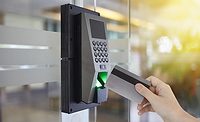The explosive growth of the cannabis industry comes with a wide range of security protocols and regulations. The global legal cannabis market is projected to reach $66.3 billion by the end of 2025, according to a 2019 Grand View Research report. The soaring legalization of medical, and recreational cannabis is propelling that growth surge. Although the cannabis market is unchartered territory for many security professionals, this sector screams of opportunities for those willing to grab hold of them.
Compliance is Key
Regulatory bodies are constantly advancing compliance standards. Licensed producers need to stay on top of them. Having the ability to secure grow houses, oversee new processes, pull audit reports and remain in compliance cannot be overlooked or underestimated. As the cannabis industry continues to mature, so does the demand for sophisticated physical security solutions to protect the process and properties from seed to sale.
Security protocols in the cannabis industry vary, from country to country, from state to state, and even from city to city. Municipalities and jurisdictions are crafting their own set of protocols and requirements, so there is no single set standard. In the state of Illinois, for instance, multiple agencies implemented the program, including the Illinois State Police and the Departments of Agriculture, Public Health, and Financial and Professional Regulation (IDFPR). Together, these agencies established security measures and regulations for the cannabis industry in the state of Illinois from beginning to end.
In Colorado, on the other hand, the medical cannabis program was overseen by its Department of Revenue, which set the foundation for Colorado’s subsequent medical, and now recreational cannabis industry. Fully understanding the specific security requirements of cannabis cultivation clients can be challenging for security integrators new to this sector. It’s critically important to read and understand the rules and the law to the letter. Case in point, permitting rules for cannabis facilities require that the operator retain 30 days of video in its archives. But, upon closer look in another section regarding the retention of records, there’s a requirement that inventory reports, employment files and electronic video archives be kept for a full year. Every specific state’s regulations in the U.S. spell out their own compliance requirements for security systems, some right down to the required camera resolution. Reading the entire rule, rather than only the security portion, is key to keeping in compliance.
Physical Security Solutions from Seed to Sale
Cannabis growing facilities and dispensaries need sophisticated security plans for a myriad of reasons. The products on sale, the funds on site and other valuables in the facility demand protection. In addition to keeping compliance top of mind, cannabis cultivators operate in a high-value product and a cash-intensive business, making them ripe targets for thieves. Intrusion detection is a critical component of a security system. And, because the cannabis industry is growing so rapidly, the security plan and the system should definitely be scalable so more stores and cultivation locations can easily be added as needed. Regulations change and facilities change. Better to invest in quality equipment and solutions now that can accommodate expansion and stay current with evolving regulations, rather than facing potential violations later.
Some of the security measures that security providers should put in place include video surveillance on the outdoor site perimeter and inside the facility, physical barriers, intrusion detection systems, and visual monitoring with adequate storage capabilities. Access to these areas must be continually restricted and logged. Inventory control measures also need to be taken into consideration and monitoring of the system also is important when it comes to security and compliance.
Most savvy security solutions providers would agree that video management and access control functionalities are more efficiently run through a single platform. For multi-site retail and cultivation operations, having a unified view of what is happening across all their locations means increased efficiency and ensures that end users can quickly and easily produce all the evidence they need to satisfy potential requests from auditors and meet compliance requirements.
Seeing is Believing
Because growing facilities house a lot of big plants and some bulky equipment, indoor camera placement needs to be carefully considered. The cameras’ field of vision shouldn’t be obstructed because cameras that are blocked are not able to do their jobs. Smart placement that maximizes viewing areas is even more essential than the number of cameras installed. As stipulated in some regulations, camera resolutions and frame rates need to be high enough to easily identify faces and movement of product throughout processing. And, because security systems should provide early detection to prevent someone from breaking in, outdoor cameras should also be equipped to send real-time notifications to multiple key personnel, including an off-site video-monitoring company. Some jurisdictions require 24-hour camera coverage, so reliable round the clock monitoring is a must.
When shopping for their security solutions provider, cannabis cultivators and retailers should ask about the firm’s experience installing systems for heavily regulated industries as well as their understanding of their specific region’s regulatory requirements. All of the components of the system - from the server to the power supply - need to be precisely designed and selected, so the more experienced they are in the cannabis arena, the better.
Checklist for Cannabis Cultivators Seeking to Secure Their Facilities
- Make sure your facility has high-definition video coverage. Key to compliance is capturing high-quality, widespread video at high frame rates.
- Choose cameras that meet your operations’ requirements and budget, and don’t scrimp on devices that provide high-definition clarity, wide dynamic range (WDR), and 360-degree views.
- Manage all of your systems from a single platform, in order to unify video surveillance with access control, intrusion detection, perimeter detection and HVAC systems and get a complete overview of your environment.
- Automate reporting to keep governing bodies informed at any time, to ensure you’re in compliance.
- Pre-program alarms and define response strategies in advance. If an incident occurs, the right system will guide you and your team through steps and decisions that keep your business compliant and secure.
- It’s also important to be able to access your operations from anywhere and receive instant notifications of potential security breaches from your mobile phone and pull up live video to see what’s happening, as it is happening.
- Set permissions and dual-authentication rules to secure more critical areas of your site such as the vault.
- Make full use of analytics to see more than the image for both real-time alerts as well as enabling comprehensive search functions during investigations
The cannabis industry continues to change and grow. Growing retail facilities would be wise to be open and flexible enough to seize the opportunities and implement the required security solutions to continue to be prosperous in this expanding market. Building new cultivation facilities is complex. But their security platforms shouldn’t be. It’s critically important to choose a partner and security solution that keeps compliance top of mind and stays in step with the ever evolving and expanding cannabis market and not let the opportunities that abound go up in smoke.




